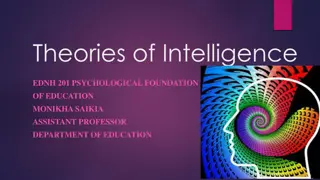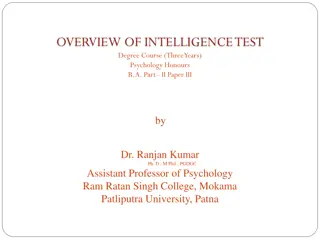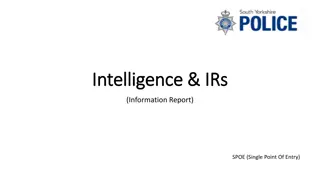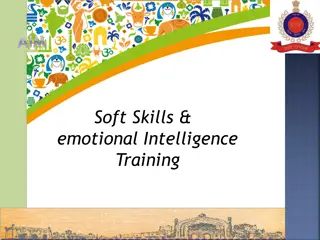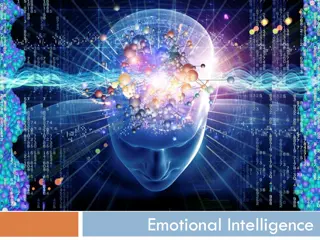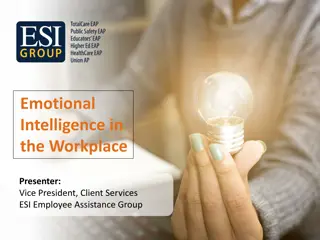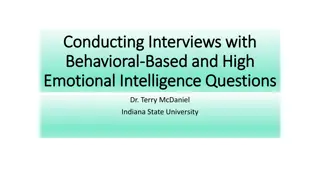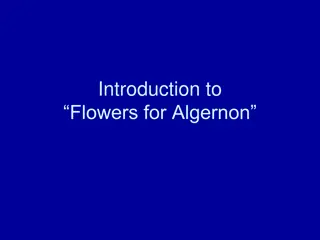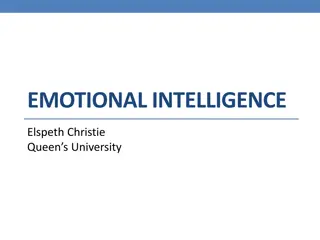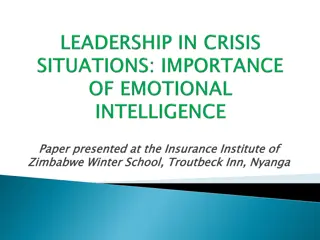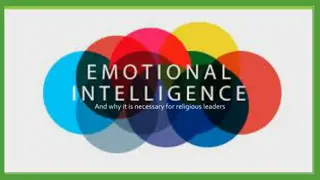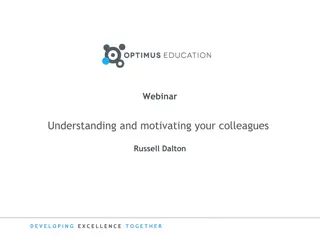
Enhancing Emotional Intelligence for Personal and Professional Growth
Explore the concept of Emotional Intelligence (EI) and its importance in perceiving, assessing, and managing emotions in oneself and others. Learn about the five domains of EI identified by Goleman and how they contribute to self-awareness, self-regulation, motivation, empathy, and social skills. Develop skills in emotional awareness, self-control, trustworthiness, adaptability, and achievement drive for improved decision-making and goal achievement.
Download Presentation

Please find below an Image/Link to download the presentation.
The content on the website is provided AS IS for your information and personal use only. It may not be sold, licensed, or shared on other websites without obtaining consent from the author. If you encounter any issues during the download, it is possible that the publisher has removed the file from their server.
You are allowed to download the files provided on this website for personal or commercial use, subject to the condition that they are used lawfully. All files are the property of their respective owners.
The content on the website is provided AS IS for your information and personal use only. It may not be sold, licensed, or shared on other websites without obtaining consent from the author.
E N D
Presentation Transcript
CH. ARUNA LECTURER IN ENGLISH HINDU COLLEGE GUNTUR
Emotional Intelligence; also called EI, describes an ability, capacity, or skill to perceive, assess, and manage the emotions of one s self, of others, and of groups. The term emotional intelligencewas coined by Salovey and Mayer in 1990, but was popularised by Daniel Goleman through his book, EmotionalIntelligence: Why it can matter more than IQ .
According to Salovey and Mayer, emotionalintelligence is a form of social intelligence that involves the ability to monitorone s own and others feelings and emotions, to discriminate among them, and to use this information to guide one s thinking and action. Goleman defined emotional intelligence as the capacity for recognizing our own feelings and those of others, for motivatingourselves, and for managing emotions well in ourselves and in our relationship.
Goleman identified the five domainsof EI as: Self awareness Self regulation Self motivation Empathy Social skills
Knowing what we are feeling in the moment, and using those preference to guide our decision making; having a realistic assessment of our own abilities and a well-grounded sense of self- confidence. Emotional awareness: emotions and their effects. Accurate self-assessment: strengths and limits. Self-confidence: Sureness about one s worth and capabilities. Recognizing one s Knowing one s self-
Handling our emotions so interfere with the task at hand; being conscientious and delaying gratification to pursue goals recovering well from emotional distress. they facilitate rather than Self-control: Managing disruptive emotions and impulses. Trustworthiness: Maintaining standards of honesty and integrity. Adaptability: Flexibility in handling change. Innovativeness: Being comfortable with and open to new ideas and new information.
Using our deepest toward our improve, and to persevere in the face of set backs and frustrations. preferences to make and guide us goals, to help us take initiative and strike to Achievement drive: Striving to improve or meet a standard of excellence. Commitment: Aligning with the goals of the group or organisation. Initiative: Readiness to act an opportunities. Optimism: persistence in pursuing goals despite obstacles and setbacks.
Seeing what people are feeling, being able to take their perspective and cultivating rapport and attunement with a broad diversity of people. Service orientation: Anticipating, recognising and meeting customer sneeds. Developing others: Sensing what others need s in order to develop, and bolstering their abilities. Cultivating opportunities through diverse people. Leveraging diversity: Political awareness: Reading a group semotional currents and power relationships.
Handling emotions in relationships well and accurately reading social situations and networks; interacting smoothly using these skills to persuade and lead, negotiate and settle disputes, for co-operation and team work. Communication: Sending clear and convincing messages. Change catalyst: Initiatingor managing change. Conflict management: disagreements. Negotiating and resolving Building bonds: Nurturing instrumental relationship. Collaboration and co-operation: Working with others towards shared goals. Team capabilities: Creating group synergy in pursuing collective goals.
The term Emotional Quotient(EQ) was coined by Baron in 1988 as a counterpart to Intelligence Quotient(IQ). EQ is measure of one s emotional intelligence, or one s ability to use both the emotions and cognitive skills. According to Dazier, EQ is the ability to perceive and express emotion, assimilate emotion in thought, understand and reason with emotion, and regulate emotion in the self and others.
Goleman identified the five domainsof EQ is Knowing your emotions. Managing your own emotions. Motivating yourself. Recognising and understand other people s emotions. Managing relationships .i.e.; managing the emotions of others.
Assessing the individual needs. Assess the schools needs. Delivering assessments with care. Maximising learning choice. Encouraging participation. Linking goals and personal values. Adjusting individual expectations. Assessing readiness and motivation for EQ development.
Foster relationships between EQ trainers, teachers and learners. Self-directed change and learning. Setting goals. Breaking goals down into achievable steps. Providing opportunities for practice. Give feedback Using experimental methods. Develop organizational culture that supports learning. Use models and examples. Encourage insight and self-awareness. Encourage application of new learning in our work.

